
15 minute read
COLTENE: Prefabricated Resin Veneer: A Case Report of a Simplified Restorative Technique
PREFABRICATED RESIN VENEER: A CASE REPORT OF A SIMPLIFIED RESTORATIVE TECHNIQUE Abstract Direct composite veneers presented some drawback when it comes to the diffi culty of execution and By Dr. Pedro Paulo Albuquerque, Dr. Marina Baretto Pereira Moreno, Dr. Alexander Cassandri Nishida, Dr. Ezequias Rodrigues, Dr. Camila Kiyohara and Dr. Carlos Eduardo Francci Th e study aims to describe the step-by-step clinical cases using sizes (small, medium, large and extra-large), two shades (transparent and bleach) and proportions based colour instability of the prefabricated composite resin veneers (PCRVs), manufactured on the golden ratio composite over time. The with the composite Brilliant New Generation (COLTENE). concepts.13-15 simplified application of the PCRVs presented as disadvantages considered for this class In the reviewed an interesting alternative in cases of smile of restorative materials. Additionally, literature, there are no clinical studies asymmetry, large defi cient restorations the high cost of the ceramic prevents reporting the use of PCRV fabricated with and discoloured tooth. In the present some patients from proceeding with the the Brilliant NG composite resin. Only investigation, the complete description of treatment.10-11 works with the PCRV produced with the the PCRVs technique can help the dentist Synergy D6 composite resin are available. during the planning and execution of Restorative protocols with direct According to the manufacturer, the treatments with the Componeer system. composite veneers have been introduced Brilliant NG resin has a diff erent organic as an alternative for patients who cannot matrix compared to Synergy D6, which Introduction aff ord the high inherent cost of ceramics. infl uence the fi nal behaviour of restorations Dental veneers have become an attractive Although cheaper, this technique presents over time. Therefore, the aim of the treatment in dentistry, spurred on by the some drawbacks, including the diffi culty in study is to describe two cases (stepdevelopment of diff erent materials and mirroring, colour matching, construction by-step) with PCRV fabricated with the techniques associated with the aesthetic of structures (ex. dentin mamelons Brilliant NG resin. patterns imposed by society.1 In general, and enamel characteristics such as patients that presented clinical scenarios translucency/opalescence) and the in the anterior teeth such as increased incorrect reproduction of the dental interdental spaces, fractures, defi cient surface texture.12 Additionally, the time restorations or colour changes are required to execute the resin veneer, indicated for treatment with veneers.2-3 the colour instability of the material, marginal infi ltration and secondary caries The success of the veneers is associated are critical factors that intimidate the with the dentist’s knowledge, the dentist.8,12 technique used, the restorative material (dental ceramics and composite resin) The PCRVs simplify the veneer Fig. 1a: Initial situation and the patient’s collaboration.4 The technique and their properties can Case 1: Single tooth restored with ceramic veneers were proposed by improve the treatment’s longevity.13 a PCRV Dr. Charles Pincus in 1938.5 Since then, The PCRV Componeer is manufactured A 42-year-old male patient presented treatment with ceramic veneers has from the composite Synergy D6 or with a debonded restoration in tooth #22 become one of the greatest themes in Brilliant NG - nanohybrid materials. The (Fig. 1a). A clinical examination revealed dentistry which give excellent aesthetic PCRVs are fabricated under controlled acceptable periodontal condition and no results. Ceramics are biocompatible, laboratory conditions in relation to carious lesions. After analysing the size of exhibit high wear resistance and great light, pressure and temperature. After the restoration and the patient’s request, colour stability. Nowadays, ceramic is these treatments, the material exhibits rehabilitation with PCRV (Componeer - the main restorative material used in improved polymerisation, reaching a Brilliant NG) was proposed. veneer treatments.8-9 However, some higher degree of conversion with lower specifi c properties such as brittleness pores and internal defects. PCRVs are The colour matching was performed and superior hardness of the ceramic available for the anterior teeth with with a colour shade guide of the PCRV in relation to the dental tissue are the 0.3-1.0 mm of thickness with diff erent system, and the A2/B2 dentin shade
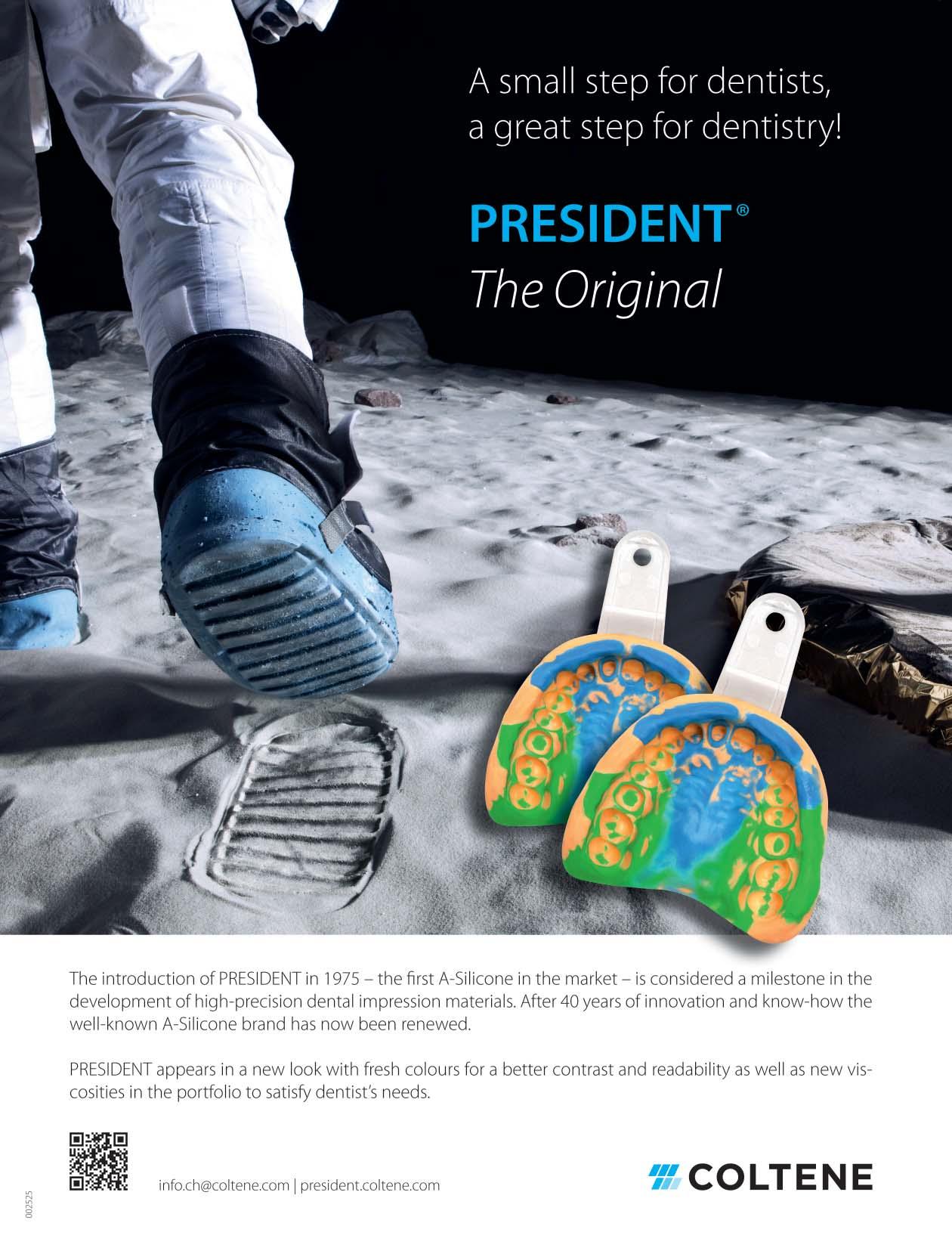
Advertisement
associated with the veneer (transparent) was selected. The colour matching of the Componeer relies on the concept of natural layering, in which two layers of the incremental technique is able to mimic the natural aspect of the teeth.
Fig. 1b: Direct restoration with Brilliant NG composite (A2/B2 dentin)

Fig. 1c: Size selection with the Contour Guide
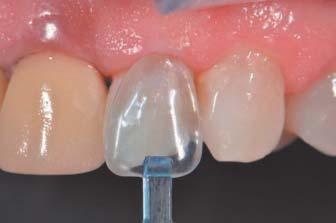
Moisture was controlled with a rubber dam and a new restoration was placed on tooth # 22 to reestablish the original anatomy (Fig. 1b). The treatment proceeded with the selection of the PCRV size (medium), using the contour guide specifi c to the Componeer (Fig. 1c). This contour guide presented diff erent sizes of PCRV for the antero-superior and inferior tooth, which enables the dentist to select the correct size for each patient, respecting the fundamentals of the aesthetic smile.
A minimal preparation was performed on the buccal surface with a diamond bur #2068 (KG Sorensen) to facilitate the setting of the PCRV (Fig. 1d). The dental wear did not involve the dentin. It is important to highlight that there is no specifi c amount of dental wear for luting a PCRV, and the dentist should evaluate minimal wear to facilitate the luting procedure. The dental substrate was etched with 37% phosphoric acid (Magic Acid, COLTENE) for 30 seconds, followed by abundant water rinse and air drying. The adhesive system One Coat Bond (COLTENE) was applied with a Technobrush (COLTENE) on the
Fig. 1d: Tooth reduction to receive the PCRV

tooth and on the internal surface of PCRV. The Brilliant NG composite resin (A2/B2 dentin) was used as the luting agent. Clinical steps of tooth wear, adhesive procedure and cementation were executed without the use of a rubber dam. However, it is important to note that the control of moisture was ensured through the insertion of the retraction cord (Pro Retract 0000, FGM). Such technique allows a satisfactory control of the gingival fl uid and facilitates the correct positioning of PCRV.
Fig. 1e: Placer Instrument of the Componeer system The veneer was fi xed on the tooth with the instrument “Placer” included in the Componeer system (Fig. 1e). Excess resin was removed after a slight compression of the PCRV. The light-curing was carried out with an LED (Radii cal, SDI) with an irradiance of 1.200 mW/cm2 for 40 seconds. The excess resin was removed and no fi nal polishing was required due to manufacturers’ pre-polishing of the PCRV (Fig. 1f). The patient was extremely pleased with the result.

Case 2: Multiple restorations with PCRV
In addition to single element (case 1), the PCRVs are also indicated for extensive rehabilitations. A 37-year-old female patient presented with an unhappy smile. Clinical examination revealed some defi cient restorations (class III and IV) with multiple colour changes (Fig. 2a). As the patient requested urgency in the treatment, a one-visit technique using PCRVs was suggested.
The restorations were removed with diamond burs (Fig. 2b), followed by the relief of the interproximal contact with abrasive stainless-steel strip (Fig. 2c). The teeth #13-23 were reduced to a minimum of 0.5 mm with a diamond bur in the buccal surface to facilitate the PCRV insertion. A haemostatic gel (Hemosthase, FGM) was applied in the gingival margin to contain possible bleeding (Fig. 2d), and a single retractor cord (ProRetract 0000, FGM) was inserted to control moisture (Fig. 2e).
Subsequently, the contour guide was used
Fig. 1f: Final aspect Fig. 2a: Initial situation
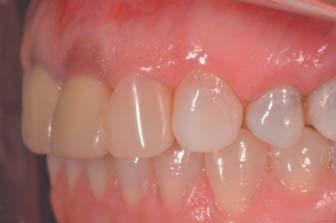

Fig. 2b: Tooth preparation Fig. 2c: Interproximal reduction with abrasive stainless-steel strips Fig. 2d: Application with haemostatic gel
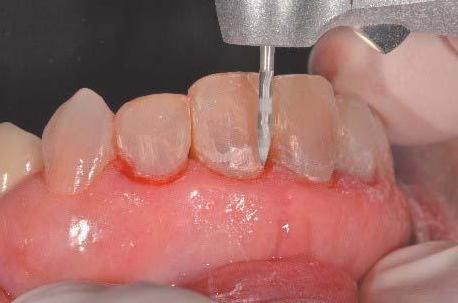
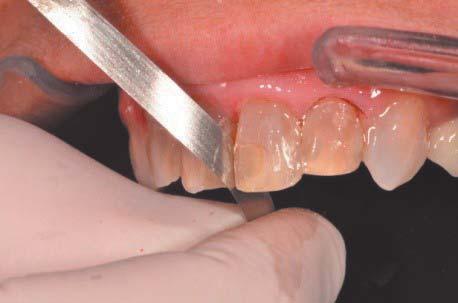
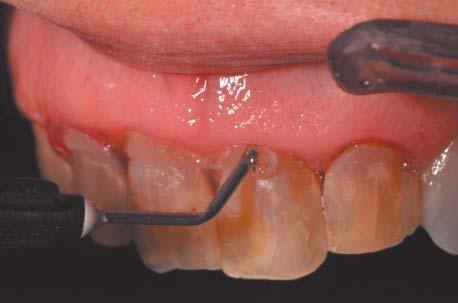
Fig. 2e: Insertion of retraction cord
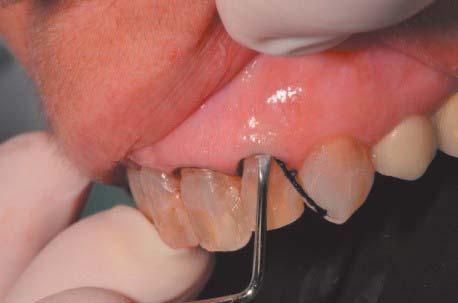
to select the veneer size (medium) and a dry proof with the PCRV was performed to view the possible fi nal result (Fig. 2f). The colour matching was performed as described in case 1, and the Brilliant NG composite resin (A1/B1 dentin) and PCRV (Bleach) were selected. A mylar strip (Epitex, GC) was inserted into the proximal regions and fixed with a wood wedge (TDV) to facilitate cervical adaptation during cementation. The teeth were etched for 30 seconds with 37% phosphoric acid (Magic Acid, COLTENE) (Fig. 2g), followed by abundant rinsing and drying. The adhesive One Coat Bond (COLTENE) was applied with a Technobrush (COLTENE) and gently airdried to remove the excess. The same adhesive system was also applied on the internal surface of the PCRV (Fig. 2h).
The Brilliant NG composite resin (A1/B1 dentin) was manipulated in a sterile glass plate to facilitate the manipulation and adaptation into the PCRV. A Componeer system instrument was used to seat the PCRV and remove the excess resin. Photoactivation was performed as described in case 1 (Fig. 2i). Cervical and proximal polishing
Fig. 2f: Dry proof of PCRV
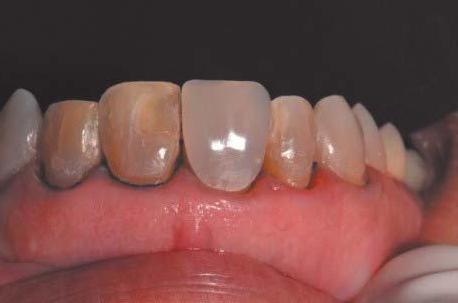
was performed with abrasive disks (Diamond Pro, FGM), felts and diamond paste. The patient was satisfi ed and very happy with the result. Finally, the proper alignment of the teeth, desirable tooth shade and harmonious smile of the patient was achieved (Fig. 3).
Discussion
There are diff erent techniques available for anterior restorations. The design of the tooth preparation can be extensive (ex. total crown) or minimally invasive (ex. veneers).5 Although diff erent, both crown and veneer treatments require multiple clinical and laboratory steps. Therefore, the single session required in the treatment with PCRV attracted a lot of attention in the dental community.17,19-21
Ceramic veneers have been considered the gold standard due to their wellknown properties.8-9 A previous study reported high survival rate of ceramic veneers, especially when the luting procedure is limited to enamel tissue.9 Additionally, the literature reported that the ceramic type and the extension of dental wear corroborate to the satisfactory results obtained.2,3,9 A well-
Fig. 2g: Acid-etching

Fig. 2h: Application of adhesive on the PCRV
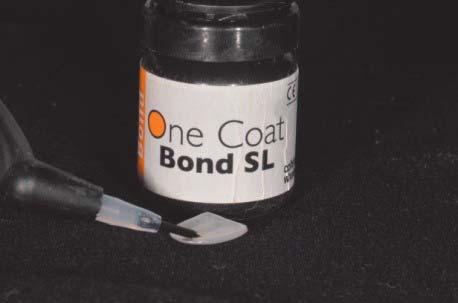
Fig. 2i: Light-curing with LED
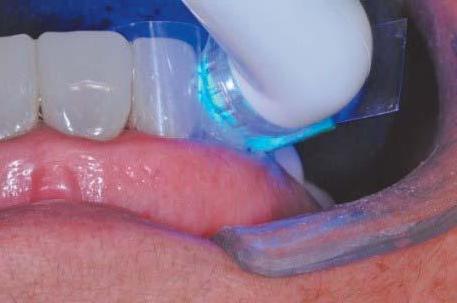
known veneer alternative is based on the use of direct composite resin. This technique provides a high reproduction of details due to the greater number of composite with diff erent shades. However, some drawbacks such as colour instability associated with the diffi culty to execute the restoration, render this technique a
hard work for the dentist. In the present study the use of PCRVs was simple and eff ective in meeting the patient’s need in only one session.
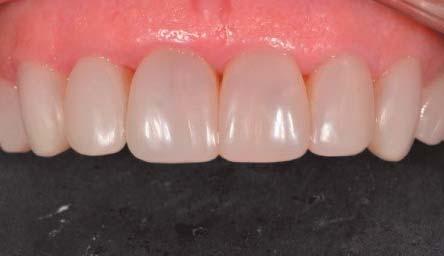
The use of indirect composite veneer is not new.8 This procedure was proposed with the Mastique Laminate Veneer (Caulk) in the 1970s.23 At this time, the veneers were produced with acrylic resin and the luting procedure was carried out using a light-sensitive composite resin. Although innovative, the inherent fragility of the acrylic veneers associated with the weak bonding to the dental tissue resulted in the failure of the system.
Recently, two systems of PCRV were proposed. The Direct Veneer (Edelweiss) was developed in 2009 and the Componeer (COLTENE) in 201124. Both systems presented PCRVs produced under laboratory conditions. It is inferred that the treatment used in the manufacturing of the Componeer could result in a high degree of conversion of the composite. In theory, this polymerisation can promote an increase in the density of cross-linked double bonds in the polymer network. This reaction can decrease the amount of non-reactive components, resulting in a
Fig. 3a
material with high strength, hardness and colour stability in relation to direct photo activated composites.14,22
Previous studies reported some diffi culties in the colour matching of direct resin restorations.13,22 An interesting feature of the Componeer system (Brilliant NG) is presented by the chameleon effect of the composite used for the veneer cementation. It is reported that this technology induces a selective refraction index of the inorganic particles in the composite formulation, which provides a lower number of the colour since the composite can reproduce diff erent shades of the VITA scale (ex. Brilliant NG A1/B1 dentin).13,16 This characteristic was confi rmed in the present investigation and one composite shade was used for the luting of the PCRV. No colour diff erence can be observed in the fi nal result. The literature reported several indications for PCRV13-16. Previous clinical studies described the use of PCRV manufactured with the Synergy D6 composite resin to solve diff erent clinical scenarios. Aesthetic reestablishment of the smile16-17, elimination of tooth darkness resulting from an endodontic treatment16,18-20 and the correction of fl uorosis stains have been reported with satisfactory results.21 However, fewer in vitro studies regarding the properties of PCRV are published in the literature. A previous work reported different results of bond strength for different materials.22 The PCRV and the ceramic E.max Press (Ivoclar Vivadent) showed similar micro-shear bond strength after thermocycle aging. Despite the results obtained, it is important to observe that the author used diff erent luting agents, which could aff ect the comparison of the fi nal bond strength results.
The longest follow-up reported with the PCRV was no more than one year.17 In relation to the composite resin, the literature reported a decrease in the surface gloss over time. Therefore, a new polish procedure is necessary to reestablish the original aesthetic appearance. Thus, despite the excellent immediate results obtained in the present study, further clinical studies with longer follow-ups should be developed and associated with laboratory researches in order to evaluate the mechanical and optical properties of the PCRV.
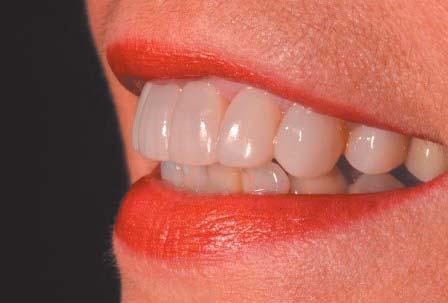
Fig. 3b Fig. 3c
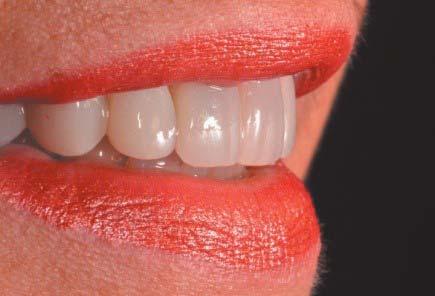
Fig.3: The fi nal results of case 2 (facial, right and left view)
Conclusion
Prefabricated composite resin veneers have been advocated as an alternative to direct composite veneers. The simplifi ed execution and improved properties of the PCRV enable results with greater longevity. It is important to highlight that this procedure does not replace the already established veneer technique with dental ceramics. DA
References:
1. Moraschini V, Fai CK, Monte Alto
R, Santos GO. Amalgam and resin composite longevity of posterior restorations: A systematic review and meta-analysis. J dent. 2015;43:1043–1050. 2. Peumans M, Van Meerbeek B,
Lambrechts P, Vanherle G. Porcelain veneers: a review of the literature. J
Dent. 2000;28:163–177. 3. Albanesi R B, Pigozzo MN, Sesma
N, Lagana DC, Morimoto S. Incisal coverage or not in ceramic laminate veneers: A systematic review and meta-analysis. J Dent. 2016;52:1–7. 4. Francci CE, Riquieri H, Nishida AC,
Saavedra GSFA. Harmonização do sorriso – Do planejamento digital à cimentação de laminados
Prepless – Parte I. Eur J EsthetDent. 2016;1(1):42–61. 5. Pincus CR. Building mouth personality. A paper presented at:
California State Dental Association 1937; San Jose, California. 6. Van Meerbeek B, Yoshihara K,
Yoshida Y, Mine A, De Munck J,
Van Landuyt KL. State of the art of self-etch adhesives. Dent Mater. 2011;27(1):17–28. 7. Pashley DH, Tay FR, Breschi L,
Tjaderhane L, Carvalho RM, Carrilho
M, Tezvergil-Mutluay A. State of the art etch-and-rinse adhesives.
DentMater. 2011;27(1):1–16. 8. Demarco FF, Collares K, Coelhode-Souza FH, Correa MB, Cenci
MS, Moraes RR, Opdam NJ. Anterior composite restorations: A systematic review on long-term survival and reasons for failure. Dent Mater. 2015;31(10):1214–24. 9. Gurel G, Sesma N, Calamita Ma,
Coachman C, Morimoto S. Infl uence of Enamel Preservation on Failures
Rates of Porcelain Laminate Veneers.
Int J Periodontics Restorative Dent. 2013;1:31–39. 10. Anusavice KJ. Standardizing failure, success, and survival decisions in clinical studies of ceramic and metalceramic fi xed dental prostheses. Dent
Mater. 2012;28(1):102–111. 11. Rashid H, Sheikh Z, Misbahuddin
S, Kazmi MR, Qureshi S, Uddin MZ.
Advancements in all-ceramics for dental restorations and their eff ect on the wear of opposing dentition.
Eur J Dent. 2016;10(4):583–8. 12. Heintze SD, Rousson V, Hickel R.
Clinical eff ectiveness of direct anterior restorations—A meta-analysis. Dent
Mater. 2015;31(5):481–95. 13. Rusher G. Direct restoration of lower anteriors with componeer by
Coltene/Whaledent. User- Report 2011:COMPONEER. 14. Gomes G, Perdigao J. Prefabricated composite resin veneers--a clinical review. J of Est and Rest Dent: offi cial publication of the American
Academy of Esthetic Dentistry. 2014;26(5):302–13. 15. Shinde TV, AS D. Componeers crowning glory of esthetic dentistry.
Int J Dental Clin. 2014;6(1):10–1. 16. Shumilovich BR, Spivakova IA, YB YB.
V Clinical Experience with a System of Direct Componeer (Coltene/
Whaledent, Switzerland) Composite
Veneers Work Diffi culties and Ways
of Overcoming Them. J Health Sci. 2014;2:604–11. 17. Martini CE, Parreiras SO, Sezsz AL,
Pupo YM, Gomes GM, Mongruel OMG,
Gomes JC. Aesthetic Treatment with
Prefabricated Composite Veneers–
Case Report. Dent O Cran Res. 2016;2(3):282–286. 18. Dietschi D, Devigus A. Prefabricated
Composite Veneers: Historical
Perspectives, Indications and
Clinical Application. Eur J EsthetDent. 2011;6(2):1–11. 19. Gonçalves R, Correia I, Cardoso
Ferreira J, Pires P, Carvalho MT,
Pina‐Vaz I. Descoloração dentinária: aplicação de facetas Componeer®
Rev Port Estomatol Cir Maxilofac. 2015;56(2):132–8. 20. Migliau G, Besharat LK, Sofan AAA,
Sofan EAA, U R. Endo-restorative treatment of a severely discolored upper incisor: resolution of the
“aesthetic” problem through
Componeer veneering System. Ann
Stomatol. 2015;3(4):113–8. 21. Du Toit J, Patel N, Montalli V, S J.
Aesthetic treatment of severely fl uorosed teeth with prefabricated composite veneers: a case report.
IntDent–AfricanEdition. 2012;2(6) 22. Perdigao J, Sezinando A, Munoz
MA, Luque-Martinez IV, Loguercio
AD. Prefabricated veneers - bond strengths and ultramorphological analyses. J Adhes Dent. 2014;16(2):137–46. 23. Haas BR. Mastique veneers: a cosmetic and financial alternative in post-periodontal care. J N J Dent
Assoc. 1982 Fall;53(4):25–7. 24. Dietschi D, Devigus A. Prefabricated
Composite Veneers Historical
Perspectives Indications and Clinical
Application. Eur J Esthet Dent. 2011;6(2):2–11.










